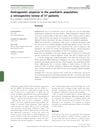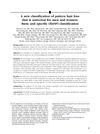Clinical, Laboratory, and Trichoscopic Features of Pediatric Androgenetic Alopecia: A Retrospective Analysis in 133 Patients
May 2024
in “
Research Square (Research Square)
”

TLDR Pediatric androgenetic alopecia is linked to obesity, family history, hormonal imbalances, and requires personalized treatment including managing comorbidities.
The retrospective study conducted by Jiangsu Province Hospital over 14 years analyzed 133 pediatric patients with androgenetic alopecia (AGA), with symptoms appearing as early as 8 years old. The study found that 39.8% of the patients were overweight or obese, 78.2% had a family history of AGA, and several had comorbidities like seborrhoeic dermatitis (51.9%), acne (42.9%), and sleep disorders (28.6%). Hormonal imbalances were common, with 47.1% having low sex hormone-binding globulin, 61% having vitamin D deficiency, and 23.6% having low ferritin. Male AGA patterns were characterized by crown thinning and temporal variations, while females showed crown thinning with frontal hair retention. The study emphasizes the need for individualized, stepwise, and comprehensive treatment, prioritizing hormonal disorders and comorbidities when treating hair loss with topical minoxidil. Regular medication and follow-up appointments were encouraged for favorable outcomes.
View this study on researchsquare.com →
Cited in this study
12 / NoResultsresearch Pediatric Androgenetic Alopecia: A Retrospective Review of Clinical Characteristics, Hormonal Assays, and Metabolic Syndrome Risk Factors in 23 Patients

research Pediatric Androgenetic Alopecia: A Review
Early diagnosis and treatment, like topical minoxidil, can prevent hair loss in children.
research Association Between Androgenic Alopecia and Coronary Artery Disease: A Cross-Sectional Study of Han Chinese Male Population
research Androgenetic Alopecia as a Marker of Metabolic Syndrome

research HSD3B1 Gene Polymorphism and Female Pattern Hair Loss in Women with Polycystic Ovary Syndrome
HSD3B1 gene variant and being overweight linked to hair loss in women with polycystic ovary syndrome.

research The Diagnosis of Androgenetic Alopecia in Children: Considerations of Pathophysiological Plausibility
AGA in children needs careful diagnosis due to low androgen levels and possible other causes.

research Early Clinical Expressions of Insulin Resistance: The Real Enemy to Look For
Recognizing and treating early signs of insulin resistance can help prevent type 2 diabetes and improve life quality.

research A Comparison of the Hormonal Profile of Early Androgenetic Alopecia in Men With the Phenotypic Equivalent of Polycystic Ovarian Syndrome in Women
Men with early hair loss have similar hormone levels to women with PCOS, possibly increasing risk of obesity and heart issues.

research Androgenetic alopecia in the paediatric population: a retrospective review of 57 patients
Alopecia common in teens, may indicate endocrine issue, minoxidil effective treatment.

research A new classification of pattern hair loss that is universal for men and women: Basic and specific (BASP) classification
The BASP classification is a detailed and accurate way to categorize hair loss in both men and women.

research Androgenetic alopecia in children: report of 20 cases
AGA can occur in children with family history; early diagnosis and treatment important.

research Classification of the types of androgenetic alopecia (common baldness) occurring in the female sex
Common baldness, also known as Androgenetic Alopecia, is caused by a combination of genetic factors and hormones called androgens.